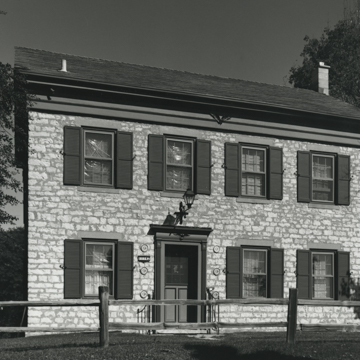Milwaukee retains scarce remnants of its pioneer architecture, but on the city’s far northwest side, originally an agricultural area, Leister’s solid limestone Greek Revival farmhouse testifies to those pioneer days. The house’s thirty-inch-thick basement foundation supports limestone walls. The roof has hand-hewn oak joists and rafters, connected by mortise-and-tenon joinery. Leister’s house lacks the front porch and classical columns found on some Greek Revival dwellings, but it has other characteristic features, including returned eaves on the side gables and a wide trim band running under the cornices, suggesting a classical Greek entablature. Using local wood, stone, and other building materials, pioneers like Leister brought the familiar Greek Revival motifs of his Pennsylvania birthplace into their new surroundings. Born in 1817, Leister arrived in 1839, becoming one of the Town of Granville’s earliest settlers. The house remained in his family until 1944. The City of Milwaukee annexed Granville in the 1950s, leaving the well-preserved house to mark the area’s rural, pioneer past.
You are here
Isaac Leister House
If SAH Archipedia has been useful to you, please consider supporting it.
SAH Archipedia tells the story of the United States through its buildings, landscapes, and cities. This freely available resource empowers the public with authoritative knowledge that deepens their understanding and appreciation of the built environment. But the Society of Architectural Historians, which created SAH Archipedia with University of Virginia Press, needs your support to maintain the high-caliber research, writing, photography, cartography, editing, design, and programming that make SAH Archipedia a trusted online resource available to all who value the history of place, heritage tourism, and learning.


